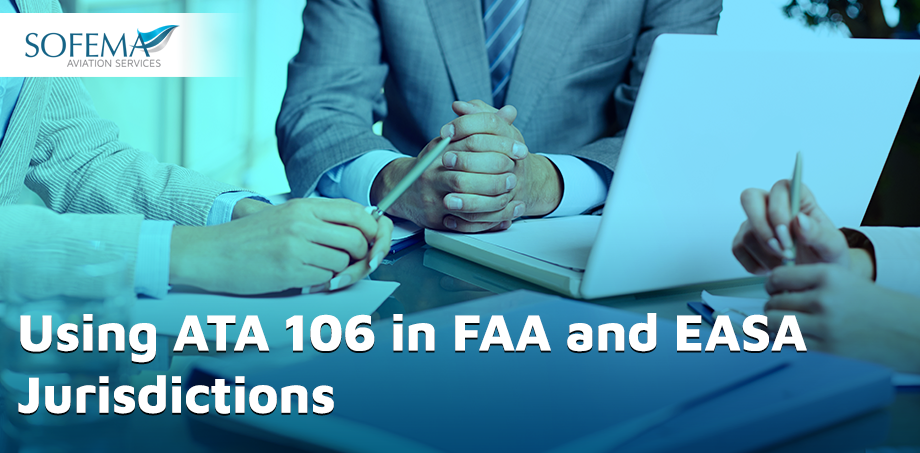Sofema Aviation Services (SAS) considers the role of the Air Transport Association (ATA) standards, including ATA 106, which are widely used and highly respected in the aviation industry.
Introduction
It should be noted that ATA Standards are both relevant and highly respected. Still, they are not mandatory under the Federal Aviation Administration (FAA) regulatory frameworks in the United States or the European Union Aviation Safety Agency (EASA) in Europe.
Instead, their adoption is voluntary. Here’s a detailed discussion on the relationship between ATA standards and the regulatory requirements of the FAA and EASA; consider the following:
Note – Both the FAA and EASA recognize the benefits of these standards and often refer to them in their guidance, highlighting their role as best practices for industry compliance and operational excellence.
ATA Standards: Voluntary but Influential
1. Industry Adoption:
Widespread Use: Despite not being mandatory, ATA standards are adopted by many airlines, maintenance organizations, and manufacturers because they provide clear benefits in terms of standardization, efficiency, and safety.
Best Practices: The standards are considered best practices within the industry, often integrated into the internal processes and documentation systems of aviation companies to streamline operations and improve communication.
2. FAA Jurisdiction:
Regulatory Requirements: The FAA has its own regulations and standards governing aviation operations, maintenance, and safety. These regulations are codified in Title 14 of the Code of Federal Regulations (CFR), commonly known as the Federal Aviation Regulations (FARs).
Guidance and Compliance: While the FAA does not mandate using ATA standards, it acknowledges their value. The FAA may reference ATA standards in its advisory circulars and guidance documents as acceptable methods for complying with regulatory requirements.
3. EASA Jurisdiction:
Regulatory Framework: EASA has established its regulations under the European Union Basic Regulation and its associated Implementing Rules. These regulations cover all aspects of aviation safety, including aircraft design, production, maintenance, and operation.
Reference to Standards: Like the FAA, EASA recognizes the usefulness of industry standards like ATA. EASA may refer to ATA standards in its guidance material, but it does not make them a regulatory requirement.
Benefits of Using ATA Standards
1. Efficiency and Clarity:
Operational Efficiency: Using ATA standards helps aviation organizations improve efficiency in logistics, maintenance, and overall operations by providing a common language and standardized processes.
Reduction of Errors: Standardization reduces the likelihood of errors in parts identification, ordering, and maintenance procedures, enhancing overall safety.
2. Interoperability and Communication:
Global Operations: For airlines and maintenance organizations operating globally, adopting ATA standards ensures interoperability and effective communication with international partners and regulatory bodies.
Documentation Consistency: Consistent documentation across different organizations and jurisdictions simplifies audits, inspections, and regulatory compliance checks.
Practical Implications
1. Voluntary Adoption:
Organizational Policies: Many aviation companies voluntarily incorporate ATA standards into their internal policies and procedures due to the operational benefits they provide.
Training and Education: Organizations often train their staff to understand and use ATA standards, ensuring everyone knows these best practices.
2. Regulatory Compliance:
Harmonization: While not mandatory, ATA standards help organizations harmonize their practices with regulatory expectations, making demonstrating compliance during regulatory reviews and inspections easier.
Enhanced Safety: Adopting recognized industry standards contributes to overall safety and reliability, aligning with the FAA and EASA’s safety objectives.
Next Steps
Follow this link to our Library to find & download related documents for Free.
Sofema Aviation Services (SAS) and Sofema Online ( SOL) provide Classroom, Webinar and Online EASA Compliant Logistics Training. Please see the websites or email team@sassofia.com
Join Our Webinar
Join us for a free Aviation Stores and Logistics Webinar Workshop. Take advantage of the latest insights and expand your skill set. – https://products.sofemaonline.com/logistics-month/
Tags:
ATA, aviation safety, EASA, Aviation Industry, FAA, Basic Regulation, Regulatory Compliance, Safety Objectives, webinar, SAS blogs, Aviation Logistics, Aviation Stores and Logistics, Air Transport Association (ATA), ATA Standards, regulatory reviews





